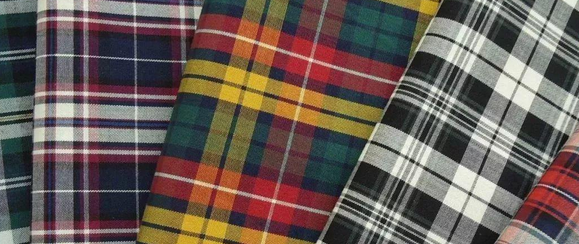Yarn-dyed weaving refers to a process in which yarn or filament is dyed first and then used to weave cloth with colored yarn. The colors of yarn-dyed fabrics are mostly bright and bright, and the patterns are also distinguished by color contrast.
Advantages: Yarn-dyed fabrics use yarns of different colors to match the fabric to form various beautiful patterns, which are more three-dimensional than ordinary printed fabrics.

Because the yarn-dyed fabric is dyed with raw yarn, the dye has strong penetrability, so the dye fastness is good.
Multi-shuttle and dobby weaving are used when weaving yarn-dyed fabrics, which can interweave different fibers or different yarn counts into varieties with rich colors and clever patterns.
Because yarn-dyed fabrics use colored yarns or patterned yarns and various tissue changes, poor quality cotton yarns can still be woven into beautiful varieties.
Disadvantages: Due to the large losses in yarn dyeing, weaving, finishing and other processes, Taiwan’s production is not as high as that of white gray cloth, so the investment cost is high and the technical requirements are high.
Yand-dyed fabric is a fabric woven with dyed yarn. Yarn dyeing is generally divided into two methods: color spinning and dyeing yarn. Generally speaking, yarn-dyed fabric refers to the fabric woven by shuttle loom. cloth, but knitting machines can also make yarn-dyed knitted fabrics. Compared with printed and dyed fabrics, it has a unique style, but the price is more expensive. Since the total loss of dyeing, weaving, and finishing of yarn-dyed fabrics is relatively large, Taiwan-made fabrics are also The output is not as high as that of white gray cloth, so the cost increases.
Features: The color fastness is better, because it is dyed yarn first, and the color will penetrate into the yarn. When printing and dyeing fabrics, you will generally find that some places are not colored when you peel off the yarn. Minimum order quantity is small. No matter what yarn weave, density, texture, or color, it can be made from tens to hundreds of meters. However, it is difficult to specially customize dyed printed fabrics without gray fabrics, and the dyeing and printing process will also limit small batch production.
Full-dyed weaving: There are dyed or partially dyed yarns in the warp and weft (or there are several colored yarns interwoven with white yarns in the fabric).
Semi-dyed weaving: The warp or weft yarns are dyed or partially dyed. The gray yarn cannot be used to weave yarn-dyed fabrics because the tension and shrinkage of the gray yarn are different from those of dyeing. The dyed yarns are different, so they definitely cannot be used in the warp direction. If used in the weft direction, the cloth surface will be deformed due to shrinkage issues during finishing. Therefore, generally colorless yarns are semi-bleached or fully bleached.
Differences
1. All-color weaving
A: In order to achieve different color effects ——It is impossible to dye the same raw material with different colors after printing and dyeing, but it can be done with yarn-dyed weaving
B: Requirements for color fastness and color light – Color fastness of yarn-dyed products Good, good sense of color and light
C: Requirement for layering-requiring a good layering
2. Half-dyed weaving
Differences in warp and weft raw materials – using different warp and weft yarn raw materials to have different performance requirements for dyeing, half-dyed weaving can be used to reduce costs and increase styles
In fact, it is very simple to judge whether the fabric is yarn-dyed fabric
Basically there are more than two colors and the same composition (such as 100% cotton, 100% polyester). All are yarn-dyed fabrics. If it is a plain color, it depends on the quality and color fastness of the fabric. Generally, the quality of plain fabrics made from yarn-dyed fabrics is better than that of dyed fabrics. The fabric surface is fresh and the lines are clear. The fastness is also higher than that of dyed fabrics
There is another way to distinguish. For dyed fabrics, the fabric is woven first and then dyed, while for yarn-dyed fabrics, the yarn is dyed first and then When it comes to weaving, generally for yarn-dyed fabrics and dyeing, just look at the front and back. If that doesn’t work, pull out a thread. If the inside and outside are the same color, it’s yarn-dyed. But if there is a layer on the outside, it’s yarn-dyed. Color, that is dyed cloth.






